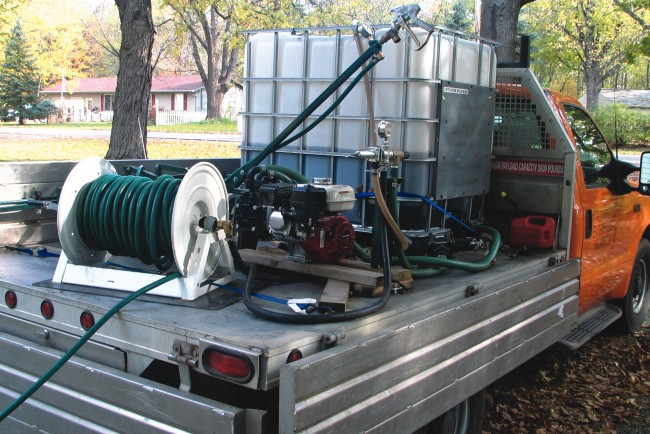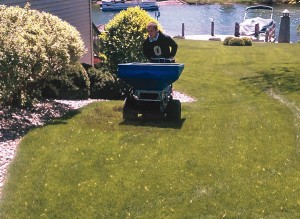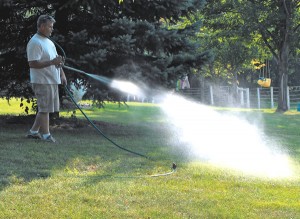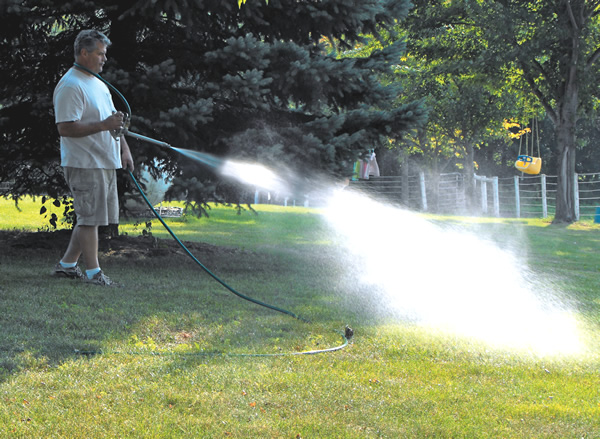Flowerfield Enterprises, an organic lawn care and agricultural services company, mixes high quality thermophilic compost and vermicompost to produce tea with the best attributes.
Rhonda Sherman
BioCycle January 2013, Vol. 54, No. 1, p. 44
Over 40 years ago, when few were aware of vermicomposting, Mary Appelhof began promoting worm bins for households to recycle their kitchen scraps. She wrote the book Worms Eat My Garbage, and when no one would publish it, started her own publishing company called Flowerfield Enterprises, located in Portage, Michigan. Appelhof traveled the globe teaching about vermicomposting, and through her company, published more books, created videos and sold earthworms and worm bins.
Nancy Essex, who worked at Flowerfield Enterprises for 18 years, became the owner of the company in 2006 after Appelhof’s death. Looking to diversify the product line, Essex felt compost tea (which Appelhof had been teaching about) might be a product that could help sustain and grow the business. She hired Joe Miazgowicz (who owned a plant business in California where he experimented with teas) to learn more about soil biology and compost tea. He started brewing 50-gallon batches and gave them to Essex’s son, Dane Terrill, who owned a golf course and was maintaining the putting greens using environmentally friendly methods. After one growing season, it was apparent that compost tea was a viable alternative to conventional turf maintenance programs.

Flowerfield has a portable 500-gallon compost tea brewer for off-site applications such as farms, golf courses and college campuses.
In addition, small lakes are abundant in southwest Michigan, where Flowerfield Enterprises is located. Runoff from fertilizers is causing water quality problems, leading some counties to ban use of phosphorus fertilizer. Flowerfield staff are assisting local lakeside communities with water quality compliance issues and educating people about the benefits of compost tea.
Organic Lawn Care
For their lawn care customers, Flowerfield begins with biological testing of soil to determine the balance of microorganisms. Test results are used to determine the annual program and become the baseline for comparing future results. Typical first year programs include core aeration, compost topdressing, overseeding and four applications of compost tea. Following core aeration, one to three cubic yards of a quality compost/ vermicompost blend are applied per 10,000 square feet. A self-propelled, motorized Ecolawn Top Dresser is used to spread the compost/ vermicompost mixture. “Adding organic matter (compost) has proven to speed up the transition process to an organic lawn,” says Terrill. “The particulate matter in vermicompost and compost cannot be replaced by tea; it is a place for the biological organisms to live, especially in yards that have had chemicals applied for several years.”

Following core aeration, one to three cubic yards of a quality compost/vermicompost blend are applied per 10,000 square feet with a self-propelled, motorized top dresser.
It typically takes two to three growing seasons of compost applications and quarterly compost tea treatments to rebuild the biology in their lawn care clients’ soils. “When we get the biology in soils balanced, we concentrate on feeding the microbes with applications of an organic fertilizer once or twice a year, in addition to an application of compost tea,” explains Terrill. “In the short run, our service is more expensive than using chemical fertilizers. In the long run, we are much less expensive.” And, he notes, there is the added protection to the environment and a safer environment for children to play.
Compost Tea Production
Flowerfield’s compost tea is made by agitating and aerating 8 quarts of a quality compost/vermicompost blend in 250 gallons of water using a GEOTEA brewer (manufactured by Greater Earth Organics in Chilton, Wisconsin). Since 2007, Flowerfield has been mixing high quality thermophilic compost and vermicompost to produce tea with the best attributes. “We find more fungi in cured compost than in vermicompost,” explains Terrill. “When we make tea, we usually brew 30 percent vermicompost and 70 percent compost, depending on what we want to accomplish. We’ve learned that the tea will only be as good as your starting material. You can’t take mediocre compost or vermicompost and make good tea.”
Fish hydrosylate, humic acid and kelp are added to the brewer and the mix is brewed for 24 to 48 hours. The aerated brewer maintains dissolved oxygen levels above 6 ppm. “Each vat of tea is monitored for oxygen content throughout the brew cycle and samples are taken and examined with microscopes to assure that we make a biologically rich and diverse compost tea,” he says. The population and diversity of bacteria, fungi, protozoa and nematodes observed determine quality.
Flowerfield requires that the compost it uses must have documented PFRP (process to further reduce pathogens) and the vermicompost must either have been through a thermophilic heating cycle or ingested by earthworms numerous times. The company uses compost and vermicompost made by Morgan Composting in Evart, Michigan. The compost is made from dairy manure and the vermicompost is made from precomposted vegetable and fruit waste. Because the incoming compost is quite dry (20 to 30 percent moisture), the microorganisms are relatively dormant. Thus, 10 to 14 days before brewing tea, Flowerfield adds water and fish hydrolysate to bring the moisture content of the compost up to 50 to 60 percent so the fungi will become active and proliferate. Three or four days later, rolled oats or oat flour are added to activate the fungi and beneficial nematodes. “The best way to combat fungal diseases is to you spray active fungi (fungal strands) on plants,” notes Terrill.
Tea ingredients can be modified as needed to combat certain plant diseases and pests. “Scheduled applications of a quality compost tea as a soil drench and foliar application will help to prevent fungal diseases and insect pests,” he adds. “Prior to typical outbreaks, we ‘spike’ tea with specific types of microbes to compete with disease and insect pests.” Tea can reduce or eliminate the need for herbicides, fungicides, pesticides and fertilizers. It also enhances soil microbial functions.
Because Flowerfield Enterprises uses chlorinated city water to make the tea, the water is aerated to off gas the chlorine. Adding humic acid or ascorbic acid (Vitamin C) will also complex the chlorines, allowing microorganisms to live and proliferate.
Compost Tea Application
Compost tea must be applied within four to six hours after removing oxygen, hence Terrill designed and constructed a 250-gallon continuously aerated holding tank mounted on the back of a truck that is used to transport and spray the tea on clients’ lawns, landscapes and gardens. Attached to the 250 gallon tank is a diaphragm pump powered by a Honda engine. Terrill recommends using a diaphragm instead of a centrifugal pump because some of the latter pumps shred microorganisms, especially fungi. “We can see the effect under a microscope,” says Terrill.

Compost tea must be applied within four to six hours after removing oxygen. Dane Terrill uses a diaphragm pump and does the application with a spray gun.
“Cleaning the brewer is as important as using good compost to make tea,” he adds. “The brewer must be as clean as new because otherwise anaerobic bioslime that can kill plants grows in the brewer. If bioslime dries in the tea brewer, it can only be cleaned off using a razor blade. The tank, pipes and hoses must be rinsed immediately after applying the tea.” Terrill recommends cleaning the tea brewer with Oxi-clean, hydrogen peroxide or bleach. Flowerfield also has a portable 500-gallon compost tea brewer for off-site brewing applications such as farms, golf courses and college campuses.
Three-Season Growing Study
To evaluate performance of the compost tea in crop applications, Flowerfield conducted a greenhouse study over three growing seasons with a local Amish farmer. The tea was inoculated with bacteria to suppress insects and applied every 10 to 14 days. The farmer applied a quart per acre of unsulphured molasses foliar feed every two weeks to increase the bacteria counts. In fall, Flowerfield Enterprises analyzed the soil mineralization and discovered that the sodium levels were too high (due to applications of cow urine as a plant fertilizer), so they flushed the whole greenhouse to remove salts. After 10 days, one-quarter inch of compost/vermicompost was added and a soil drench with compost/vermicompost extract was applied. According to Terrill, tomato yield increased from 8 lbs/plant to 20 lbs/plant in one year using compost/vermicompost tea.
Flowerfield worked with another Amish farmer during a severe drought and compared his corn yields with those of his neighbor, who used conventional farming methods. This included nonstop irrigation, GMO seed and fertilizer at seeding, and herbicide and fungicide applications. His yield was 106 bushels/acre. The Amish farmer did not irrigate, used a soil drench of compost extract in the spring, applied compost tea and mycorrhizae fungi (1 lb/acre) to furrows during seeding, and sprayed compost tea foliarly at the first true leaf and on June 15th. His yield was 95 bushels/acre of corn. However, says Terrill, the conventional farmer’s corn had six percent protein and sold for $7.40/bushel. He grossed $784.40/acre, but his inputs cost $315.00/acre, so he netted $469.40/acre. The Amish farmer’s inputs included operating two John Deere tractors and using herbicides, fungicide and millions of gallons of water. He used horse-drawn equipment and a gas pump on a sprayer. His corn had 10.5 percent protein and sold for $15.50/bushel. He grossed $1,472.50/ acre, and paid $278.00/acre for inputs and $35.00/acre for harvesting. His net income was $1,372.50/acre, according to Terrill.
Rhonda Sherman is a freelance writer and consultant, and a vermicompost extension specialist at NC State University in Raleigh, North Carolina.










